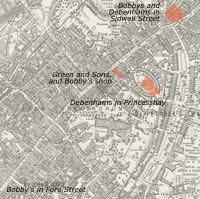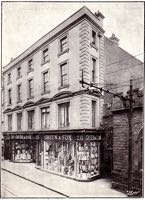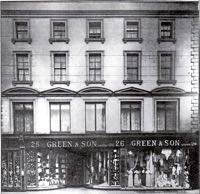
- Home
- Memories
- Scrapbook ▽
- Topics ▽
- People ▽
- Events
- Photos
- Site Map
- Timeline
Page updated 1st May 2017
Return to Retail Exeter
Also see:
Building the New Debenhams
Debenhams last sale
 Debenhams of Exeter occupied one of the most
prominent buildings in the city until 2007, when they moved to their new
Princesshay store. So how did such
a large retailer first establish itself in Exeter?
Debenhams of Exeter occupied one of the most
prominent buildings in the city until 2007, when they moved to their new
Princesshay store. So how did such
a large retailer first establish itself in Exeter?
We have to go back to a 1456 document regarding the lease of shops in the High Street "opposite 'Le Newe Inne' in the Parish of St. Stephen". The New Inn was appropriately, newly built on land that belonged to both the Chapter and the Chamber (the Cathedral and the City). The inn was long a point of issue between the Cathedral and City for its encroachment onto city land.
Over the years, the inn was remodelled and its rooms adapted for various uses. In 1554, the City resolved to move the Cloth Hall established at le Egle, opposite the Guildhall to the New Inn. It was established in 1555 when it was described as "..a commodious hall for all manner of clothe, Lynnen or wollyn, and for all other m'chandises and w ch shalbe called the m'chants hall."
After 1612, the New Inne Halle or Merchant Hall was let separately from the New Inn as an Exchange for cloth merchants - the merchants rented stalls in the hall to conduct their trade.
Work on the famous Apollo Room, which survived until 1942, was started during the Civil War. It measured 10 metres by 7 metres wide and there were various coats of arms decorating the room, including the Royal Coat of Arms, the City of Exeter arms, and those of some prominent Devon families.
Situated on the High Street, between the Half Moon and St Stevens Bow, the New Inn was initially set back from the street. Over the years, shops were built in front of the inn. The Cloth Market was moved to St John's Hospital School in 1778 which initiated the slow decline of the New Inn. The end came in 1833, when it closed and Green and Son opened its drapery shop. By 1900, Green and Son was a flourishing business and on the 9th February 1912, not to be outdone by its competitors they took delivery of their first van, a 20 hp Ford in black and brown.
The history of Debenhams starts with a business opened in Margate during 1887, when a Mr F J Bobby bought an already established drapery store. In 1900 it became a limited company and expansion followed through the years with stores in Leamington Spa, Folkestone, Eastbourne, Torquay, Cliftonville, and Bournemouth. In 1922, they took over the business of Green and Son in the High Street. When Mr Bobby retired in 1927, the business was sold to Debenhams and his son became chairman of the group.
Debenhams date back to 1813 when a partnership of Thomas Clark and William Debenham opened a store in Wigmore Street, London. The business was incorporated in 1905 when they opened their first department store.
They were listed on the Stock Exchange in 1928. Branches were added in Southsea, Reading, Worthing, Worcester and Totnes. During 1937, considerable improvements were made to the Exeter building and they became the largest store in the High Street. A restaurant was added with an in-house orchestra that would play during dinner and tea.
The blitz of May 1942, saw Bobbys destroyed - a report after the raid said:
"The fire guards at Messrs Bobby and Co, were on duty on the roof and were successfully dealing with the I.B.s (incendiary bombs) but were continually driven off the roof by machine gun fire. Between this menace and the flames spreading across the street they were unable to cope with both difficulties and the flames starting from Messrs. Bobby's spread to Messrs. Deller's Cafe through the portion of the building above Lloyds Bank".
Trade was quickly moved to a smaller store, now the Co-op, in Fore Street, where they remained until 1964.
In March 1962, work started on the new Bobbys, at the junction of Sidwell Street and the High Street. With Bovis Ltd as the main contractor, 340 men and 60 subcontractors worked to complete the 140ft, 123,000 sq m, seven story, concrete and steel building, in 25 months. The estimated cost of the building was £825,000. Designed in January 1961, the architect for the building was George Baines and Syborn, who seem to have taken particular care to make the building blend in with the surrounding city!
On 5th March 1964 the building was opened by the Mayor. The new store employed 250 people trading on six floors with 60 different departments. A special design feature was the restaurant on the top floor which catered for 300 customers and had a 50 ft long window giving views across the city to the Haldon Hills. It is said that the basement was built to be nuclear bomb proof and could be used by the authorities in a national emergency. On 8th December 1972 the store was renamed Debenhams in a move to consolidate the name across the UK.
In January 1985, raiders wielding sawn-off shotguns snatched £15,000 cash, the days takings, from Securicor guards at the rear entrance of the store. The men, wore fake wigs and moustaches, when they surprised the two guards and a female member of staff. Armed police officers wearing bullet-proof vests were soon at the scene. They ringed the King William Street car park with officers and sniffer dogs searched the area, but the men escaped in a Ford Cortina. The car was found abandoned three days later in Cathedral Close. Securicor offered a £5,000 reward for information leading to the arrest and conviction of the raiders.
In September a member of the armed gang was arrested and found himself in court. A Kent man, Jeffery Tucker and two accomplices had been involved in 22 armed raids, including the one in Exeter. He was sentenced to 18 years in prison, for the Exeter raid, 16 other armed offences, and shooting three security guards.
In 1987, the Times did a survey of the worst buildings in Britain with the Debenhams building making it into the top 10. The building gives a great view across the city from the restaurant on the top, and it is often used for abseiling events to raise money for charity. The roof is also a favourite for letting off fireworks at Christmas and New Year. It was announced in November 2010 that John Lewis was to take on the old Debenhams building for a John Lewis at Home store, occupying five of the eight floors. It was revealed that the single story frontage would have an extra floor added to the Land Securities owned building. The new store is focused on furniture, furnishing accessories, electrical and home technology. Computer terminals in the branch allow shoppers to browse the wider John Lewis range.
When Land Securities decided to redevelop Princesshay, an important feature of the plan was for a large department store as the flagship business of the development. Within a short time of the announcement of the plans, Debenhams had negotiated an option on the new facility. The new Debenhams, in Bedford Street has twice the floor area of the old store. There is a main entrance facing Southernhay, paved with Portuguese stone blocks and a restaurant overlooking the Cathedral, giving stunning views across Princesshay Square.
Sources - Express and Echo clippings, Debenhams website, Exeter Burning by Peter Thomas and other articles on Exeter Memories.

Green and Sons in the High Street. St Steven's Bow is the gap to the right. The site is currently Thomson Holidays and The Link.

The frontage of Green and Sons. The interior of the building included the vestigaes of the old New Inn.
│ Top of Page │